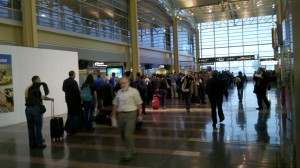Perhaps American political differences can be explained by expectations about future income
One of my favorite cousins traveled all the way from the hills above San Francisco Bay to attend Jon Stewart’s Rally to Restore Sanity in Washington, D.C. this weekend. Stewart’s assertion is that political discourse in this country has become too angry and that if people are reasonable, common ground can be found. This led me to wonder how much common ground there already might be among Democrats, Republicans, and Tea Partiers.
Could there be values or religious differences among the parties? I would argue that these are of slight importance to most Americans. My evidence for this is that most Americans claim to be Christian yet spend money on a new SUV rather than driving a 5-year-old Honda Accord and giving what would have been the SUV payments to help the poor and suffering. Christian Americans very seldom follow the teachings of the historical Jesus when those teachings conflict with financial goals. A voter might have a personal preference about whether or not evolution should be taught in public schools, but is not likely to sacrifice personal consumption to realize that preference.
That leaves economic policy as the area of real dispute. Yet if you listen to politicians from the three parties, they all seem to want substantially the same things: a lavishly funded military and continued foreign wars, government transfers of money from working to non-working Americans (e.g., Social Security), unlimited government expenditures on medical care for those over 65 and for poor Americans (i.e., Medicare, Medicaid, and Obamacare), government workers enjoying high salaries, early retirement, and a comfortable inflation-adjusted pension.
The only important point of difference seems to be whether or not the above-mentioned “wants” are affordable for American society. For people who believe that America’s future prosperity will be much greater than today’s, the 2009 and 2010 federal budget deficits totaling $2.7 trillion (CBO source) are hardly worth worrying about. That’s about 20 percent of today’s GDP, but it would be only 2 percent of 2020’s GDP if we were to enjoy real GDP growth of 25 percent annually instead of our historical average of 3.3 percent . Similarly the unfunded pension obligations of states and cities, estimated at perhaps $4 trillion (Economist), will be easily affordable by a future generation of very highly paid American taxpayers.
Looking at the U.S. Census Bureau’s historical median income table (follow the P-5 link), Voter A could look at the median male worker’s income rising from $22,648 (2009 dollars) in 1953 and reaching $34,762 in 1973, perhaps because all of the technology innovations of World War II had finally been fully adopted by American industry. If that trend were to start again in 2010, perhaps explained by enthusiasm over the iPad, we could all expect to have 50 percent more income in 2030 than we do today and it would be correspondingly easier to pay off our debts, pension obligations for past and present government workers, and for the world’s most expensive health care. Voter A would presumably think it very reasonable for a politician or party to propose an expansion of government spending, in the same way that a college student might prudently borrow money in the expectation of having a reasonably well-paying job at age 35.
Suppose that Voter B, however, happens to concentrate on a different section of the same table. Voter B notices that median income for a working male American was actually lower in 2009 than in 1973, having slipped during those 36 years to $32,184. Voter B expects the average American to be no better off in 2030 or 2036 than he or she is today. Thus Voter B would think it insane for the government to propose spending a future generation’s money, in the same way that it would be insane for a 55-year-old to borrow money planning to pay it back at the age of 70.
The purported great divide and incivility among Americans in political discourse might be as simple as one group that thinks 2010-2046, economically, will look like two replays of 1953-1973 back to back while the other group thinks it will look like 1973-2009. As nobody has a crystal ball, there is really no way to be sure who is right. So perhaps on this election day we can be mindful that the person voting for the opposing party actually wants all of the things that we do; it is simply that he or she has a different expectation about American wealth circa 2046.
[The posting is not meant to minimize the importance of the choices that voters face. If optimistic Voter As prevail and are wrong about America’s future wages, the country is bankrupt. If pessimistic Voter Bs prevail and are wrong about America’s future wages, we’ll have unnecessarily deferred a lot of things that we desire.]
[You might ask why I considered only male Americans in this discussion. It is because women changed the way that they participated in the workforce over the years in question. It is more sensible to compare a male working in 1953 to a male working in 2009 than to do the same for women, whose educational and professional opportunities have been so greatly expanded.]
Full post, including comments